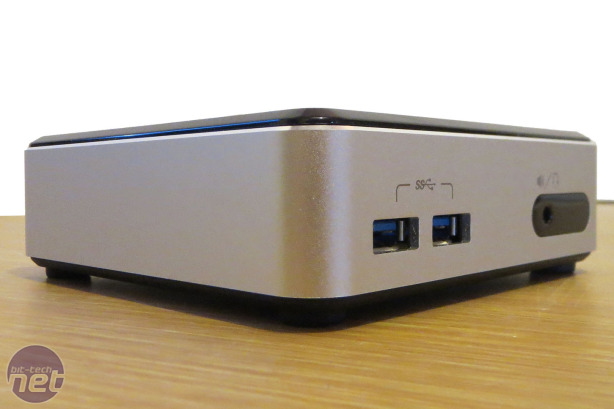
Intel NUC D54250WYK / WYB Review - Performance Analysis
The new NUC’s processor has an improved architecture, but previous tests have shown that Haswell isn’t that far ahead of Ivy Bridge when it comes to application performance – and so performance improvements are minimal.The updated board scored 1,274 in the image editing benchmark, which is a little ahead of the 1,201 from last year’s model, and it’s also faster in this benchmark than AMD’s top-end APU, the A10-6800K, which scored 1,090 - even knowing how far AMD CPUs generally trail the competition this is still a surprising result.
The Haswell chip scored 1,783 in the video encoding benchmark which, again, is ahead of the 1,550 scored by the older NUC. The AMD chip takes the lead here, though, with a score of 2,129.
The two Hyper-Threaded cores in the Haswell processor scored 1,043 in the multi-tasking benchmark, which squeaked ahead of the Ivy Bridge board’s 989 result.
Those benchmarks combined for an overall score of 1,366 from the Haswell board, which sneaks ahead of the 1,247 pace of the Ivy Bridge part. The AMD A10-6800K returned an overall score of 1,447.
The improved graphics core in the new NUC was also faster than the older machine’s weaker GPU, though not by as much as we might have expected. The new chip’s minimum framerate of 34fps in Left 4 Dead 2 at 1,280 x 720 was five frames quicker than the older board. We upped the resolution to 1,680 x 1,050 and left the quality settings at High, and the Haswell GPU hit a minimum of 26fps – three frames faster than Ivy Bridge.
The final area of improvement in Haswell concerns power consumption. The new machine beat its predecessor in these tests, with idle and peak requirements of 9W and 24W, bettering the 11W and 29W figures recorded from the older machine. The small fan on the underside of the board spun up when stress-tested, but it’s quieter than last year’s model so you’ll only notice the noise in an extremely quiet room.
Our NUC uses an Intel 530 Series SSD, which is only a little faster than the 525 Series SSD we used in last year’s NUC. In the ATTO disk benchmark test the new NUC returned read and write figures of 544MB/sec and 517MB/sec – the older drive scored 531MB/sec and 509MB/sec in the same tests.
Intel NUC D54250WYK / WYB Review - Conclusion
Intel’s latest NUC board deploys one of the firm’s new Haswell processors and, while it doesn’t make a huge leap forward in application performance, it’s better in every department: a little faster in software, a little improvement in gaming performance, a little lower power consumption and a little less noise.This board doesn’t just improve in benchmarks, either. It’s got more USB 3.0 ports than its predecessor, an on-board SATA connection, and a case that’s smaller and includes an infrared receiver. Both this year’s board and kit are a little cheaper, too.
The new NUC impresses, then, but it comes with the same caveats as older models: AMD’s APUs are still better for gaming and some applications and, when the component costs are totted up, desktop Core i3 or AMD A10 machines will be cheaper, though of course larger. If you want to build your own tiny PC, though, or need a small, frugal PC with a decent level of power, this is the best NUC yet.
-
Speed37 / 45
-
Features27 / 30
-
Value23 / 25


MSI MPG Velox 100R Chassis Review
October 14 2021 | 15:04










Want to comment? Please log in.